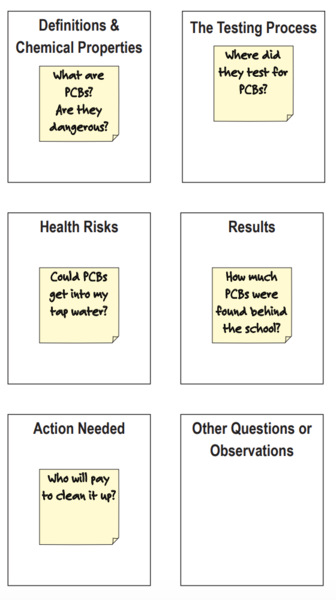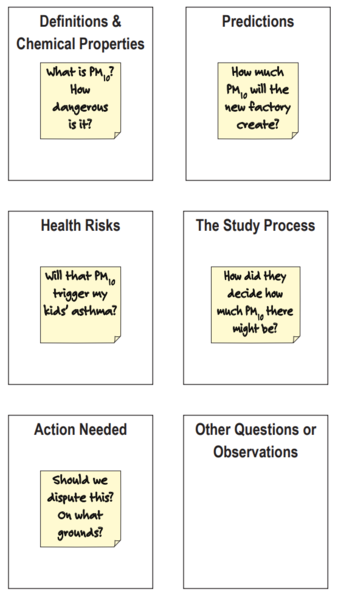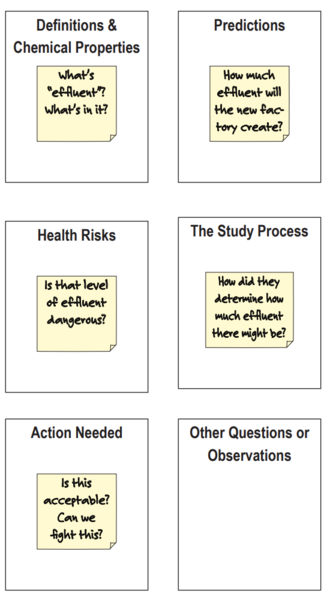Adapted from the Statistics for Action Air Quality Unit "A First Look at Technical Documents" and generously shared with permission. You can access a printable version of this guide at sfa.terc.edu. Click here for a Spanish language version of this guide.
Overview
This workshop guide helps participants examine selections from a technical document. They record their observations and questions on sticky notes, and group those notes by category. Then they discuss next steps needed to identify information in the document that will help their campaign.
When to Use This Guide
When a community has a technical document that seems impenetrable and they don't know where to begin. Depending on the group's questions, follow this workshop with other activities from Making Sense of the Data, Drawing Your Own Conclusions, and Pieces of the Risk Puzzle.
Notes for Facilitator This workshop does not offer strategic advice about how to proceed with a campaign after reading a technical document, or about whether and how to challenge the findings in the document. Understanding your document is an important first step, but your strategy will depend on many things -- politics, state, regulations, economics, and more.
Time: 60 Minutes
Preparation
Choose which kind of technical document you have:
- Environmental Testing Results Reports
- Environmental Impact Statements
- Permit Documents
Select 1-2 pages from each "typical section" of your document. If possible, enlarge each of the selected pages on a photocopier. Post one large blank sheet labeled "Other Questions or Observations." Prepare blank poster paper sheets with the Categories of Questions & Observations that match your technical document:
- Definitions and Properties
- The Process
- Results (or Predictions)
- Health Risks
- Action Needed
Materials
- Enlarged selected pages or extra copies from the technical document (posted on the wall or tables of the meeting room, leave plenty of space between them)
- Participant prompts (one per posted document page, taped to that page)
- Blank sheets with Categories of Questions and Observations (posted on the wall or tables)
- Sticky notes (medium-sized)
- Markers and pens
Step 1: Set the Stage (5 minutes)
Tell participants that technical documents (environmental test results, environmental impact reports, permits, what have you!) can be confusing, and while we might not be able to understand everything about them, together we can make sense of a few selected excerpts. If we figure out what questions we still have, that will help us determine next steps.
Step 2: In pairs or small groups of 3-4 (20 minutes)
Give each person sticky notes and a pen or marker. Divide into pairs or small groups. Tell each group to start with one of the technical document pages posted. After reading each page, they should share their observations and questions with each other, then write them on sticky notes and post them on the pages (one question or observation per note).
Encourage them to write specific questions -- ones that will make sense if they are moved around and read by another participant. You may want to 'seed' a few pages with some notes of your own. Groups move from page to page, until they have visited most pages.
Step 3: Organize (10 minutes)
Turn the group's attention to the blank Questions & Observations sheets. Ask participants to take a few sticky notes off the the technical documents and move them to the sheets that best fit each question. If participants are not sure where to move some notes, they can discuss with each other or you. Keep going until all the sticky notes are categorized. When this is done, take a few minutes to look at the categorized questions together. Participants then write their names next to any questions they think they can answer.
Step 4: Debrief (15 minutes)
- Lead the group in discussion. As needed, share your own observations.
- How was that experience? What patterns did you see? What insights did you have?
- Which questions and observations stand out as most important?
- Which questions need to be answered first to help the group's goals?
Tell the group that questions can be answered in different ways: using resources, looking online, asking experts, doing activities at future meetings. Some questions have no specific answer, but can guide the work.
Step 5: Next Steps (10 minutes)
Discuss and identify steps needed to answer the questions identified as most important or that need to be answered first. Possible next steps include:
- Divide up questions about definitions or technical processes among members of the group. Ask a few people to research the answers before the next meeting. They can develop expertise on on the topic, and then teach the rest of the group.
- Do a related Statistics for Action activity at the next meeting to help with a key concept.
- Consult an EPA or engineering expert between meetings, or bring them to the next meeting.
Strategies for Reading Environmental Testing Results Reports
These reports show the results of tests in which samples of soil, air, water, or sediment were taken from specific locations, brought to a laboratory, and examined to see if the samples show evidence of certain chemicals. They show where the samples were taken, how much contamination was found in each sample, and how the levels of contamination found compare to any applicable legal standards.
A report may be written by multiple organizations. A common scenario: The EPA or DEP commissions the tests and decides where to sample, but contracts with an environmental engineering company to do the actual work. The engineers then take the samples, but contract with a chemical laboratory to analyze the samples. Then the lab returns the raw results, the engineering company summarizes the most important findings, and the agency determines if any action is needed.
Remember, the reports will not show contamination in locations that were not tested, or of contaminants for which the lab didn't or couldn't test. For more details about soil or water testing, review the Soil Quality Guide: Digging into the Dirt and Water Quality Guide: Read Before You Drink on the SfA web site.
Typical Sections
Select a typical page or two from each of the following sections, if available:
- Narrative summary of report
- Tables with a summary of the most important data
- Maps of the site with testing locations marked
- Tables of full lab results, including results both over and under the detectable limits
- Descriptions of samples from the field (temperature, pH)
- "Chain of custody" reports

Categories of Questions & Observations
Below are typical categories into which questions and observations can be grouped.

Strategies for Reading Environmental Impact Statements
An Environmental Impact Statement (EIS) or Report (EIR) is a written summary of an environmental impact assessment. An assessment is required when a new project (factory, development, construction) might have an impact on environmental or human health. In some cases, an EIS is made before cleaning up a polluted site, to see if the cleanup itself would put anyone at risk.
An EIS answers the question, "If this proposed project goes forward, how could it affect the environment and/or public health?" It will not answer the political question, "Should this project be allowed to proceed?"
Typical Sections
Select a typical page or two from each of the following sections, if available:
- Introduction explaining why the project is being proposed
- Description of the places that might be affected
- Variety of alternatives for implementing the project. One should be a "No Action" alternative, predicting impacts if things were left as-is. This is used as a baseline for comparing the other alternatives.
Analysis of the environmental impacts of each of the alternatives, including things like:
impacts to threatened or endangered species
- impacts on air and water quality
- impacts to historic and cultural sites
- social and economic impacts on local communities
cost analysis for each alternative, including costs to mitigate expected impacts
Optional or Additional Sections:
Evidence of funding for the complete project
- Proposed environmental mitigation plans, if the preferred alternative will cause significant impact

Categories of Questions & Observations
Below are typical categories into which questions and observations can be grouped.

Strategies for Reading Permit Documents
Permits are granted by government agencies. Many documents are generated in a permitting process. Permit granting is political -- a balance of socio-economic benefits vs. environmental degradation. Granting or renewing a permit requires public involvement, where people can comment on both sides of that balance.
- A permit application is a document proposing a new project. The proposing company fills out the application. A government agency then decides whether or not to grant the permit, and what restrictions the permit should specify. Most permits eventually expire and must be renewed.
- A release permit lets a company put a certain amount of pollution into the water, air, or soil in a period of time. This can be called a release, discharge, runoff, or effluent.
- A site permit allows a company to construct a building and parking lots, checking to see if the company has a plan (both during construction and long-term) for dealing with water, sewage, trash, construction pollution, electricity, traffic, stormwater runoff, etc.
- Other permits limit the amount or type of fuel a company can burn, or how much water or power they can use. Special permits are required for companies whose business is storing or treating hazardous waste.
Typical Sections
Select a typical page or two from each section. Section names vary greatly, depending on the type of permit and the granting agency. Focus on the issue you care about most. If you think the company isn't being truthful, use sections that depend on numbers provided by the company. Most permit documents specify exact numbers for each building, tank, boiler, furnace, machine, etc. regulating:
- what it does, and how long and how often it can operate
- what chemicals are used and how, where and how they are stored, and any possible contact with people
- how much fuel, water, or power it can consume
- how much contamination it can release in a period of time
- how often it should be monitored and inspected, and how that information should be kept and reported

Categories of Questions & Observations
Below are typical categories into which questions and observations can be grouped.

Originally published by TERC in 2014 with support from the National Science Foundation and shared with permission. Any materials posted on Public Lab are not endorsed by TERC or NSF and do not necessarily represent the views of either organization. Images courtesy of the Rini Templeton estate.
0 Comments
Login to comment.